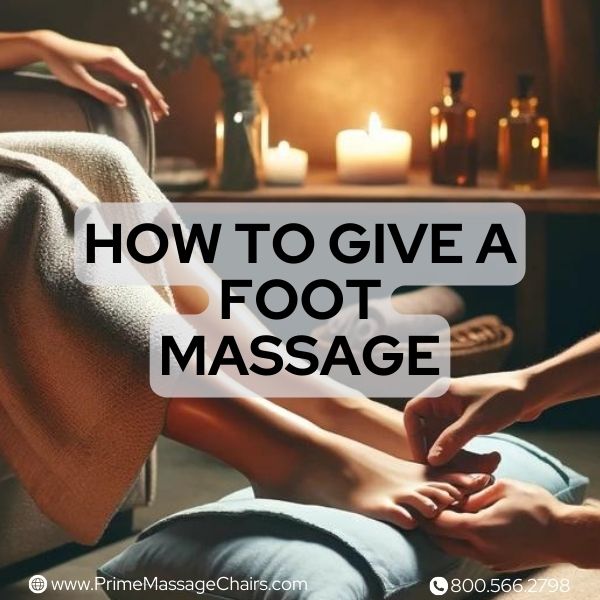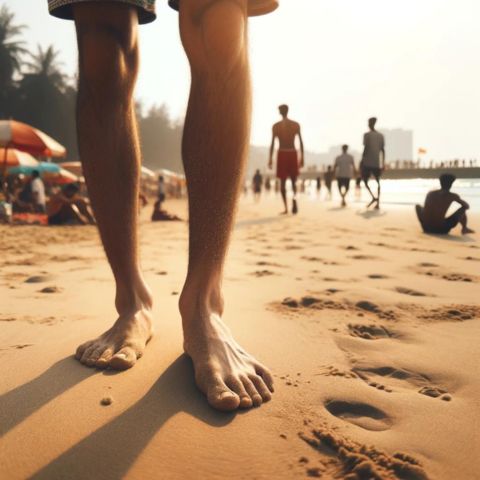
How To Give A Foot Massage
Wondering how to give a foot massage? If so you're in luck because today you'll learn some techniques that are great for soothing tired feet and promoting relaxation.
This article walks you through simple yet effective foot massage techniques to help melt away stress and soothe your soles.
Now let's dive in and learn how to pamper those feet!
Understanding Basic Foot Anatomy
The human foot is a complex structure made up of 26 bones, 33 joints, and over 100 muscles, tendons, and ligaments.
This design helps with balance and supports your weight when you stand, walk, or run.
The arch of the foot plays a crucial role here. It's formed by the tarsal and metatarsal bones along with supporting ligaments and tendons.

Key to walking and running smoothly is the plantar fascia. This thick band stretches across the bottom of your foot, maintaining the arch's shape.
Toes also have an essential job in keeping us balanced on our feet.
They consist of phalanges – small bones similar to those in fingers – serving as support during movement.
Necessary Supplies for a Home Foot Massage
Now that you've learned about basic foot anatomy, it's time to gather the right supplies for a home foot massage.

Having these items on hand will ensure the massage is both effective and enjoyable.
- Foot Lotion: Choose a lotion that is specifically made for feet to moisturize dry skin and improve massage movements. Foot lotions often contain ingredients like essential oils that can provide additional stress relief.
- Tennis Ball or Foam Roller: These are great for rolling under the foot arches. This exercise helps stretch and massage the muscles of your feet, aiding in recovery after the massage.
- Warm Towel or Washcloth: A towel soaked in warm water and then wrung out can be wrapped around each foot after massaging. This helps increase circulation and adds a relaxing warmth.
- Candle: Lighting a candle creates a soothing atmosphere, making the massage more enjoyable. The gentle light and fragrance add to the overall relaxation experience.
- Massage Timer: Use a timer to keep track of how long you're massaging each part of the foot. This ensures both feet receive equal attention and benefits from the therapy.
Please note, when selecting a foot lotion with essential oils, be mindful of any sensitivities or allergies to specific ingredients to ensure the massage is both safe and enjoyable.
Foot Massage Techniques
Learn various foot massage techniques to soothe tired feet and improve overall well-being.
Warmup Twists
Warmup twists help relax the feet before a full massage. First, hold the foot with both hands.
Gently twist each side in opposite directions, like you're wringing a towel.
This movement should be smooth and slow to warm up the muscles without causing any pain.
Keep twisting from the heel to the tip of the toe for about 30 seconds.
Next, focus on rotating each toe gently between your fingers. Start from the big toe and move towards the little one.
Rotate them clockwise and then counterclockwise to boost circulation and flexibility.
The twist not only prepares the foot for deeper massage techniques but also relieves tension right away.
Arch Rubs
After loosening up the foot with warmup twists, move on to arch rubs for deeper relief.
This technique focuses on the arch of the foot, an area that often holds a lot of tension.
Use your thumbs or knuckles to gently but firmly massage back and forth across the sole's instep.
This motion helps alleviate stress in the middle part of the foot and can be particularly soothing for those who stand all day or have flat feet.
For added comfort, apply some massage oil to reduce friction and make the massage more enjoyable.
Arch rubs not only help relax tight muscles but also support better foot health by improving circulation.
They are especially beneficial for people experiencing plantar fasciitis or heel pain.
Keep your movements slow and deliberate, allowing the person receiving the massage to enjoy each stroke's therapeutic benefits fully.
Toe Bends
Toe bends help each toe get the attention it deserves, much like the Toe Tango technique suggests.
Gently grasp each toe between your thumb and forefinger. Bend them slowly back and forth to stretch the muscles underneath.
This action eases tension in areas prone to stiffness from walking or wearing tight shoes.
After working on the toes, move on to engage the sole of the foot with a foot spread technique for comprehensive relaxation.
Foot Spread
To start the foot spread, gently hold the heel with one hand. Use your other hand to pull the top of the foot outward.
This stretches the muscles on the inside of the foot and helps relieve tension from hours of standing or walking.
Make sure you move slowly and ask for feedback to ensure comfort.
Next, switch hands and repeat the stretch on the other side of the foot. This time, you aim to stretch muscles along the outer edge.
It's great for people who suffer from issues like bunions or hammertoes.
Keep each stretch gentle but firm, holding it for a few seconds before releasing.
Heel Squeeze
Gently grasp the heel of the foot with one hand on either side. Squeeze softly but firmly, using even pressure to relieve tension in the heel area.
This technique is especially helpful for those suffering from conditions like metatarsalgia, as it can alleviate pain and inflammation.
Move your hands in small circles to cover all parts of the heel, making sure not to miss any sore spots.
Now, transition into knuckle or fist work by lightly making fists and using them to knead deeper into the foot's muscles.
Knuckle or Fist Work
Knuckle or fist work is a key technique in foot massages. You use your knuckles to apply deep pressure on the heels and other specific areas of the foot.
This method helps relieve pain, improve circulation, and boost relaxation.
Be careful around the Achilles tendon to avoid discomfort.
Next, learn how thumb work can enhance your massage skills.
Thumb Work
Thumb work plays a crucial role in foot massage, especially for hitting those specific pressure points.
Start by positioning your thumb underneath the big toe and then apply gentle circular motions.
This technique helps in targeting areas that need extra attention, like the arches known as the plantar fascia, which is often tight and sensitive.
Move on to massage under each toe bone with your thumbs, using more circular motions.
It’s important to distribute pressure evenly across the bottoms and tops of feet without straining your thumbs.
Use body weight to aid in applying pressure rather than relying solely on thumb strength.
Addressing tight spots on calf muscles with thumb strokes can significantly reduce discomfort or pain, enhancing relaxation during the massage session.
Pressure Points
Pressure points on the feet can help relieve tension and promote relaxation. To find these spots, use a map of foot reflexology as a guide.
Gently press different areas on the foot to see where your friend feels tightness or tenderness.
Focus on these areas with careful pressure. Start from the heel and move towards the toes, pressing each point for a few seconds.
Use techniques like thumb work or knuckle massage to apply deeper pressure once you've found tender points.
Remember, communication is key. Ask if the pressure feels okay or needs adjusting.
Applying pressure to specific points on the feet may potentially offer benefits such as pain management and improved mental well-being, though experiences can vary.
Now let's move on to special tips for an even more successful foot massage.
Special Tips for a Successful Foot Massage
Use the Toe Tango technique to make sure every toe gets proper attention and relaxation.
This can especially help people who wear tight shoes or have sore toes from standing all day.
It's not just about touching each toe, but also flexing and rotating them gently to release tension.
Find pressure points on the feet for a deeper massage experience. Targeting these areas can offer relief from stress, migraines, and even aid in better sleep, though individual responses will vary.

A successful foot massage combines knowledge of these points with gentle yet firm strokes across the entire foot.
This approach ensures both relaxation and therapeutic benefits, making your foot massage more effective.
Potential Benefits of Foot Massage
Foot massages can help people relax, making it easier to fall asleep and improve mental health.
After a long day, getting your feet massaged melts away stress and tension.
This simple act of care boosts mood and creates a sense of calm.

While many people report positive outcomes from foot massages, including relaxation and pain relief, it's important to note that responses to massage therapy can vary widely, and scientific studies on its benefits are ongoing.
To ensure safety and appropriateness of foot massages for individuals with diabetic neuropathy, it is crucial to consult healthcare professionals before beginning any massage regimen. This consultation can help manage potential risks, especially since reduced sensation in the feet might lead to unnoticed injuries.
Risks and Considerations in Foot Massage
While foot massages can offer numerous benefits, it's important to proceed with caution for some individuals, especially those with certain health conditions.
Individuals with diabetes are advised to consult healthcare professionals before receiving foot massages to carefully manage potential risks related to sensory changes and ensure that massage techniques do not adversely affect their condition.
These conditions elevate the risk of injury since they might not feel the pressure or pain during a massage.
People suffering from ailments like ingrown toenails, blisters, or recent foot surgery need to avoid massages in affected areas to prevent further complications.
Pregnant women are advised to consult with healthcare providers before receiving foot massages, as specific pressure points, particularly around the ankle and heel, may be associated with stimulating uterine contractions.
Always seek advice from a certified massage therapist who understands these risks and knows how to tailor a session safely.
Although foot massages are widely enjoyed for their relaxation and health benefits, individuals with existing medical conditions, including but not limited to diabetes, circulatory issues, and pregnancy, should consult with a healthcare professional before initiating any new massage therapy regimen.
This consultation ensures that massage techniques are tailored to their specific needs and circumstances, avoiding any potential adverse effects.
FAQs
What do I need to start giving a foot massage?
To give a foot massage, you only need your hands. Using your palms, gently rub the entire foot, paying extra attention to calluses or trigger points for relief.
Can a foot massage help with pain in other parts of my body?
Yes! A good foot massage might ease cramps and pain not just in your feet but also in the lower extremity areas, like legs, ankles and knees since it improves circulation.
Are there special techniques for massaging different parts of the foot?
Yes, different areas like the heel bone or near the toes require gentle pressure with specific movements such as circular motions by a masseuse trained in massage therapy.
How can technology aid in giving better foot massages?
Mobile apps on devices like Android can guide you through techniques or suggest ways to include tools like orthotics for added comfort during a DIY home session.
Should I consult any professional before trying out foot massage therapies at home?
While most people enjoy a simple home-based foot care regimen, consulting with professionals is wise if you have certain medical conditions requiring medication or specialized tertiary advice.
Conclusion
Giving a foot massage can be an amazing way to help someone relax and feel better.
Learning the right techniques and understanding the anatomy of the feet will make your massages more effective.
Remember, it's important to have all your supplies ready and check for any foot issues before starting.
This simple act of care can bring comfort and relief, making it a valuable skill to learn.
Although foot massages can offer numerous benefits, individuals with health concerns or conditions should always seek the guidance of a healthcare professional before beginning any new massage therapy regimen to ensure it is safe and beneficial for their specific health situation.
While foot massage is widely recognized for its potential to relieve stress and improve well-being, individual experiences may vary, and not all claimed benefits are equally supported by scientific evidence.
We hope you've enjoyed this article and learned how to give a foot massage the right way. Thank you for reading!
Disclaimer:
We do not provide medical advice. The content of this article, including text, graphics, and other material, is for informational purposes only. It is not intended to be a substitute for professional medical advice, diagnosis, or treatment. Always seek the advice of your physician or other qualified health provider with any questions you may have regarding a health condition. Never disregard professional medical advice or delay in seeking it because of something you have read in this article or on our website.
